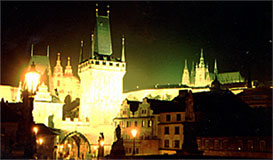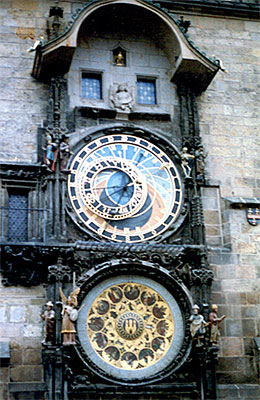|

|
The astrological clocks
of Münster and Praha
Prague |
As far back as the man can remember, the sky always intrigued him.
There the prehistoric thought probably saw the supreme power wich
was commanding the time, the day, the night, the seasons.
Following the Ptolémée's Tetrabiblos, IInd century, already in the
XIIIth and XIVth century, more and more precise correlations are seeked
between cosmic, geographic facts and the periodicity of planets. In
the XVth century, astrology deeply participates in the mediaeval mode
of living and we find it at any classe of the european society during
the renaissance.

Clock of Prague
|

Clock of Münster
|
Construction of the Clock
Then the first astronomical clock was constructed in the Dom of
Münster in 1408 by the cistercian monk Friedrich in this very cultural
context, inclined to observe stars and speculate on metaphisics. In
this connection, we can notice that the contribution of technical
construction of the cistercian monastic order was preponderating.
As early as the XIIth century, almost all their 500 monasteries had
one or several water-mills, and their engineers developed two apparatus:
the cam and the crank which transformed the linear movement into a
rotative one. However, according to J. Needham, the indispensable
craggedness principle came from Chineses and was introduced in Europe
in 1335-1364, probably by Marco Polo's coreligionists. And the construction
of the first complete astronomical clock dates back to 1364, 44 years
before the one of Münster.
The astrological clock of Praha is situated in the tower of the town
hall wich was built by Kadau in 1410 and reshaped by master Hanus
of the Rose in 1490. The panel of the calendar; ornate with some peasant
scenes, is a copy of the Josef Manés' work of 1864.
The astrological clock of Münster was completely destroyed in 1534/35
during the anabaptists revolts. This sect born of protestantism recommended
return to literal interpretation. The descriptions of this first clock
are missing but we may suppose that it was constituted of a procession,
a celestial face, a calendar, like any other clock at this time. The
present clock was constructed seven years later, in 1542. Besides
the date is noted in front of the facet of the balcony sustaining
the parade of the automatons. The clock is the common work of printer
Theodor Tzwyvel and franciscan Johann Aquensis, who made the calculation
and developed the astronomic system, and locksmith Nikolaus Windemaker.
Brigitte Vattheuer - The cathedral as space of the
world - February 1988
|


